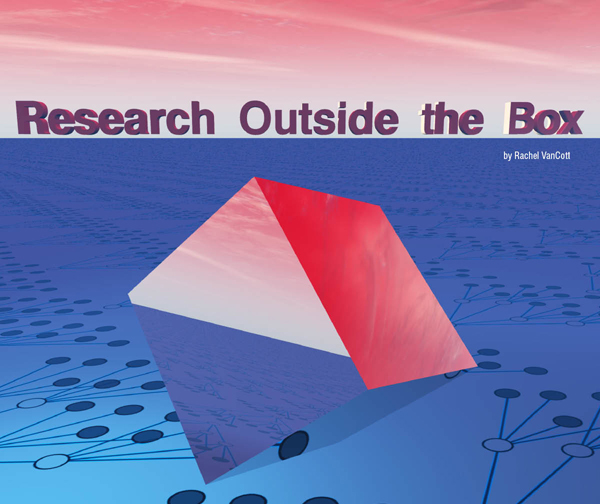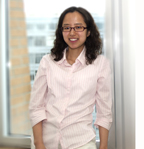

When she came to graduate school, Myung Jin Choi had a simple formula for academic success: “I’ll just study day and night, really hard, for five years and I’ll be like the top researcher in the world, and I’ll graduate.” Back home, in Korea, she’d seen documentaries in which successful people told stories of the productive but stressful and largely sleepless years that brought them to great heights, and her tireless efforts had served her well so far—MIT was Jin’s top choice for graduate school. But once she settled into her research, Jin realized that there’s much more to it than simple perseverance. Sometimes—in fact, most of the time—research calls for a bit of creativity and a willingness to reconsider what you know.
When she joined LIDS, Jin’s first project was sponsored by multinational oil company Shell. Shell was interested in locating pockets of petroleum stored beneath the ocean floor. Since oil and natural gas are often found near vertical salt formations, called salt domes, which form under the sea bed, scientists use seismic waves to map those features and predict the best places to drill. But the information obtained according to this procedure is incomplete and noisy. Jin’s task was to create a model that could help process the data gathered by the geophysicists.
Under the aegis of her advisor, Professor Alan Willsky, Jin set out to develop a model based on the so-called graphical model, which represents the statistical relationships among a collection of random variables using edges and nodes of a graph. Following approaches of her former labmates, Jin started with a multiscale tree model—which could efficiently represent the relationships between data points using a hierarchy. This type of model looks like a stick drawing of a tree, just like the name suggests. It’s shaped like an inverted tree, where one node is connected to four more nodes, and each of those branches out to four more, and so on.
The tree model was elegant, but complicated for two-dimensional fields, because to build an accurate tree model, it was necessary to map many variables into each node of the graph. After only one semester in the lab, Jin felt she was stuck. It was around that time that she spotted a poster for an informational session about MIT’s Africa Information Technology Initiative (AITI) —an initiative that sends teams of students to various parts of Africa, where they teach Java programming to high school and college students. Jin had always been interested in using her skills and education to benefit others, and this looked like an ideal opportunity to share her knowledge. Her advisor gave his blessing, and Jin jumped at the chance to travel far from the lab and think about something else for a while.
It takes nearly a day to fly from Boston to Nairobi, Kenya. Jin was excited about the trip, but she admits that she was nervous during the flight. As an undergraduate, she’d visited Japan and China, and spent one year studying at the University of California, Santa Barbra as an exchange student, but she was still getting used to the cultural change that came with moving to U.S. and she wondered how she’d be received in Africa.
“Would they perceive us as arrogant Americans who came [as if on a vacation]?” Jin remembers wondering. Would the group seem like patronizing outsiders? Despite her concerns, Jin and the other members of her group found a warm reception. The students were eager to learn and the cultural difficulties that Jin anticipated never materialized, although there were a few communication issues. “English is a second language for both them and me,” says Jin, laughing “so... some barriers were there.”
For six weeks, Jin devoted her energy to her new responsibilities in Kenya. She and four other MIT students divided the work, delivering lectures, preparing assignments, dealing with hardware issues, devising advanced problems for the more ambitious students and—according to the report they wrote after the trip—coping with the lack of hot water at the group apartment.
After the whirlwind of the trip, Jin’s attention returned to her research problem. Suddenly, she found herself taking a new look at her assumptions.
“I decided it’s better to have a simple model that approximates something, rather than a really complicated model that’s exact. So that was a change,” says Jin. Instead of rigidly adhering to the tree shape, she came up with the idea of adding a few extra edges within each scale of the model. This would create a model that looks like a pyramid, and allow connections between nearby nodes in different branches, rather than requiring that all connections run through the hierarchical edges.
“At first it seemed like a ridiculous idea,” Jin says. Adding those extra edges would allow each node to have one variable rather than many, but it would also create loops in the graph—a characteristic generally believed to make models more difficult to use. But Professor Willsky encouraged her to stay with the thought and develop it further.
Recent advances in theory have produced several solutions to the loop problem, and Jin was able to use algorithms to manage the complexity created by those extra edges. The final product produced a more efficient way of arriving at the solution. Jin also worked out a way for scientists to update their results when more data were collected, without having to start over. That feature is bound to be valuable for geologists and geophysicists who may collect data over a period of years or decades.
The “ridiculous” idea that came to Jin on her flight back from Kenya turned into the foundation for her masters thesis, and inspired her current PhD work as well. Collaborating with her labmate Venkat Chandrasekaran, Jin modified the pyramid-shaped model so that it can pick up additional relationships that are left out of the tree model. They applied this new method to model relationships between monthly stock returns and were excited to see that it captured many interesting connections. One of the strongest of these connections was between Microsoft and Apple, which the standard tree-hierarchy places in completely different branches of the tree because the two belong to separate divisions (Microsoft belongs to the Services division and Apple to the Manufacturing).
This experience left Jin with a lesson about creativity. “Your productivity is not necessarily proportional to the number of hours you work each day,” says Jin. To do good research, you need to be creative, and to be creative you need to leave some space in your life to find inspiration.
I work on weekends as well, and I work at home,” says Jin, “In grad school, there’s no break. You are a gradate student.” But she makes sure to spend time away from her work every once in a while. Since returning from Kenya, Jin became a member of EECS-REFS—a peer mediation group that lends a friendly ear to students who are having professional or personal issues. Jin remembers how supportive the graduate community was when she was first starting out at MIT and wants to return the favor, offering support to incoming students and to international students in particular.
Jin also doesn’t limit herself to working at her desk or in her lab. Some of the best ideas come to her at night, when she’s laying in bed, organizing her thoughts, she says, “When I don’t have a paper in front of me, I tend to think at a high level.”
She looks for inspiration from all the usual sources—the scientific literature, and in conversations with friends and labmates. But in the end, Jin feels that every research project demands a fresh idea—a spark of novelty. After all, a research project is, by definition, something that’s never been done in quite this way before.
